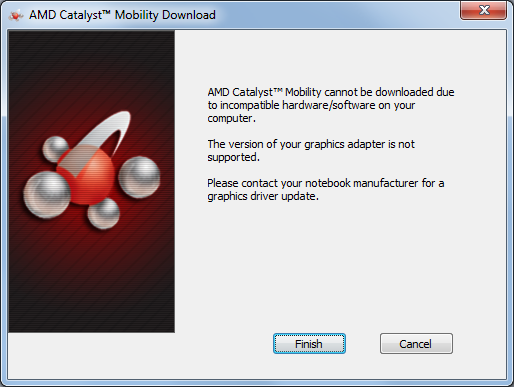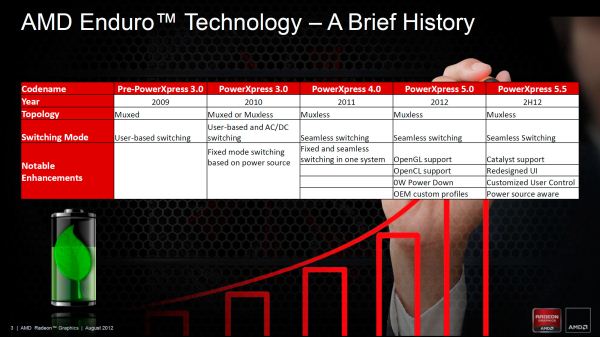AMD’s Enduro Switchable Graphics Levels Up
by Jarred Walton on September 6, 2012 3:00 AM ESTRecap: AMD’s PowerXpress, aka Dynamic Switchable Graphics, aka Enduro
Getting back to the switchable graphics, AMD has gone through a variety of names over the years. Here’s AMD’s summary slide, which I’ll discuss in detail:
Originally introduced as PowerXpress back in 2008, the first AMD switchable graphics solutions were like that found later in the ASUS UL80Vt and similar laptops: you had to flip a switch, and in the first iterations you would then need to reboot the laptop so that the BIOS could disable the discrete GPU and activate the integrated GPU. It was messy and a bit inconvenient, and NVIDIA’s early studies showed that many users ended up not using the feature—they would either run on dGPU all the time or on iGPU all the time. Both AMD and NVIDIA had a second series of switchable graphics designs where the need to reboot was removed; the first Alienware M11x could switch GPUs in about 10-15 seconds, and the same was true of HP’s first ENVY laptops. These were using PowerXpress 2.0 and 3.0, and for most people the switching side was adequate: you’d run on dGPU when plugged in and switch to iGPU when on battery power.
Last year, AMD took a step forward with their switchable graphics by introducing PowerXpress 4.0, which also renamed the technology to Dynamic Switchable Graphics (DSG for short). I got a chance to do a head-to-head of the technology using a Sony VAIO C laptop provided by NVIDIA. You know a company is confident that they’re going to win a technology comparison when they’ll actually give you a competitor’s product. In some cases, DSG was just as good as Optimus: you could launch a supported game and never realize all the extra stuff happening in the background; unfortunately, there were several titles where it wasn’t quite as convenient as we would have liked, and OpenGL support from DSG was completely missing.
Step forward to early 2012 and we got another update to PowerXpress 5.0 (note that PowerXpress is now only used internally by AMD and hasn’t been their marketing name since before PX4.0) along with a rechristening: Dynamic Switchable Graphics was out and Enduro was in. If nothing else, at least it makes my job easier as Enduro is much more concise. There's also the fact that the GPUs are no longer "switching", as the iGPU is always running; now the dGPU is simply supplementing the iGPU when needed. Along with the name change, AMD added OpenGL and OpenCL support to the mix, and with their Zero Core Technology (which is also part of their 7000 series desktop GPUs—a case of mobile design influencing desktops) the need to keep a small portion of the chip alive (aka BACO: Bus Active Chip Off) was removed. OEMs could also ship with custom profiles for applications, so for example Dell might want all of their extra utilities to default to running on the iGPU.

Hopefully this problem goes away next month!
Other than those changes, the UI and driver updates situation on early Enduro solutions remains largely the same as with DSG/PX4.0—and that’s what I initially received with the Clevo P170EM, with drivers from around March 2012. A quick check at AMD’s site also let me know that there weren’t any new drivers available, as the P170EM wasn’t currently supported by the latest Mobility Catalyst drivers.











200 Comments
View All Comments
arcticjoe - Thursday, September 6, 2012 - link
Would be nice if the article reflected a more detailed picture of the problem with AMD's enduro problem - with Enduro enabled 7970m performance is crippled, where is many games you get the same low fps on lowest settings as you do with ultra, so even my 6970m can outperform it and give me much smoother framerates.yes I can get 36fps in BF3, but if I lower my detail settings to low or increase my GPU clocks fps will stay the same, so its difficult to competitively play multiplayer games.
It has now been nearly half a year since I paid £1700 for my top of the range laptop, but after spending literally hundreds of hours on re-installing drivers, windows, messing around with various settings I am now at wits end. Meanwhile AMD have been doing their best to pin the issue on someone else and when cornered with a mountain of evidence they've had a thread with many hours of logged data removed from NBR forum.
As much as I hate other people saying this about any manufacturer, i can confidently say this is the last time I pay for any AMD product. Faulty product, with no support
coder543 - Thursday, September 6, 2012 - link
I've said this for a long time, and I'm going to say it again.If you aren't happy with a product when you buy it, you should return it. You aren't guaranteed to have updates which will fix the issues you're having. The product was sold as-is.
I like AMD, they have good products. Apparently their support for the Clevo with 7970M is a bit lacking, so I wouldn't buy that. It doesn't mean I'm going to boycott all of their products. If I buy something of theirs and it isn't working, I'm not going to sit around and hope it'll get fixed. I may return it and hold off buying a competitor's product for awhile to see if it gets fixed, but you're trying to pin this on AMD.
AMD messed up, but you didn't hold them to it, and so now you're stuck with a bad product. Clevo has a 30 day full refund return policy. If all of the people with these problems would have returned these laptops with the 7970m GPUs, then Clevo would have thrown the boxes of them in AMD's face, saying they want a working product. That's putting your money where your mouth is, but you let Clevo and AMD have your money, which let's them believe you're satisfied.
arcticjoe - Thursday, September 6, 2012 - link
Problem is that being one of the first adopters I was told that this was just a drivers issue and any week now AMD will release some new drivers and fix this problem. Issue was reported to AMD very early and initially they replied with "we are looking into this issue and it will be resolved soon". Since I had no reason to doubt AMDs word or abilities so I stuck with the product. This was 5 months ago, so now I am pretty sure there is a design fault somewhere and the card probably cannot be fixed without a hardware modification.Montage - Thursday, September 6, 2012 - link
Moreover, most people didn't even know there was a problem. They didn¨'t know that they weren't getting what they paid for. Not all games have this issue and the 7970M does perform better than some of the ancient cards people used before getting the 7970M.There is a thing called WARRANTY, that should guarantee you a fully working product at least as long as that warranty lasts (which is 1-2 years, not 30-days...)
transphasic - Sunday, September 9, 2012 - link
Yes, I agree with you, and I DID buy a two year warranty as a precaution against this type of thing, but Sager and the reseller said NO WAY to my request to have my 7970m swapped out for the far better, far more powerful Nvidia 680m.In short, my TWO YEAR warranty will not cover this, and is virtually worthless to me now. What good is a warranty that won't protect my investment?
Vozier - Thursday, September 13, 2012 - link
do you have accident coverage? maybe your laptop can fall down your balcony.... just saying.... and maybe then you can ask for the swap paying the difference? LOL....I still think the 7970 is a good price value option, keep it and next year you might buy the 7990 or an 8000 and spende as much as you will buying a new 680M NOW... so take your calculator and run some numers before deciding.
vgray35@hotmail.com - Thursday, September 6, 2012 - link
Exactly. It takes 2 to 3 weeks to install and test everything which is a painful exercise in its own right. Spending a little time to resolve issues is normal, and now the 30 day return time period has passed. AMD said - don't worry a fix is coming soon. By the time you realize AMD was full of shit the 30d refund period has lapsed. Coder543 is living in a dream world.AMD has proved themselves to be rather a cocky bunch of people, who are in dire need of a reality check.
hulawafu77 - Thursday, September 6, 2012 - link
That's not fair. With all GPUs, it's expected that drivers are not rock solid at release. It takes more than 30 days usually for it to be working at full throttle, this goes for Nvidia as well. It took Nvidia months before they had drivers that didn't have FERMI running like a volcano. We were told drivers were coming. The 30 days were up, 5 months ago and still no drivers.JarredWalton - Thursday, September 6, 2012 - link
Who told you drivers were coming, AMD or Clevo? If it was Clevo, you should be taking it up with them. I think AMD's driver crew has been working feverishly for months to try and get Enduro 5.5 all gussied up and ready for release. Why did it take so long? Because this isn't just a quick fix; they're doing some fundamental changes that require a lot of work, testing, and validation. If everything works out (and that's still an "IF"), this is the first Enduro/AMD Dynamic Switchable solution that I can see being worthwhile. NVIDIA worked for at least six months to get Optimus ready before showing it to the world, and I'd wager pretty heavily that NVIDIA has a larger mobile driver team than AMD.vgray35@hotmail.com - Thursday, September 6, 2012 - link
Yes, Jared I agree. They have been working hard to fix the problem, and we all want to see the results of that effort thank you very much.But why was it necessary for them to put pressure on forums to delete valuable data on this issue, and thereby effectively launch a direct attack against their highest paying customers? Tell me how this stance by AMD in any way helped towards development of this fix. As far as I know NVIDIA resolved their problems without any clandestine maneuvers against their customers.
They changed the name to Enduro in order to further hide the issue from an unsuspecting public. That is a further salvo across the bow of their highest paying customers, and hoping to maintain sales by changing the name to "ENDURO", which says nothing about what the product actually stands for. It stands for what we refer to in commerce and law as: Bad Faith. Sager aided and abetted this fiasco, and continues to do so.
I am a software engineer, and I fail to see how taking action against their customers helps the development of the software, and how the continuing adherence to BAD FAITH helps at all.
Yes. Problems need time to fix that is true, and that is a fact of life we all have to live with. But we do not have to live with overt attacks against us from an arrogant marketing team.